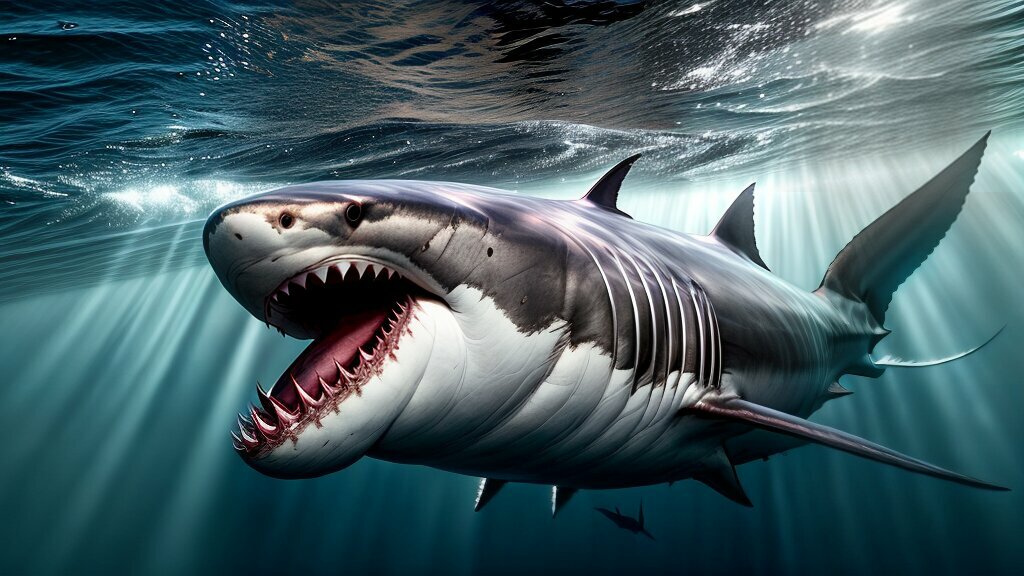Great white sharks are one of the most feared creatures in the ocean. Their large size and sharp teeth have captivated human imagination for centuries. But, what about their blood temperature? Are great white sharks warm-blooded like mammals or cold-blooded like reptiles? In this section, we will explore this question and uncover the truth behind the blood temperature of great white sharks.
- Key Takeaways:
- Understanding Warm-Blooded and Cold-Blooded Animals
- The Biology of Great White Sharks
- Blood Temperature in Great White Sharks
- Comparing Great White Sharks to Other Warm-Blooded Fish
- Warm-Blooded Sea Creatures: Beyond Sharks
- Conclusion
- FAQ
- Q: Are Great White Sharks Warm Blooded?
- Q: What are the differences between warm-blooded and cold-blooded animals?
- Q: How do great white sharks regulate their body temperature?
- Q: What is the blood temperature of great white sharks?
- Q: How do great white sharks compare to other warm-blooded fish?
- Q: Are there other warm-blooded sea creatures besides sharks?
Key Takeaways:
- Great white sharks are not warm-blooded in the same way as mammals.
- They possess unique adaptations that allow them to regulate their internal body temperature to some extent.
- Further research in this field is necessary to fully understand the complexities of great white sharks and their remarkable physiology.
Understanding Warm-Blooded and Cold-Blooded Animals
Before we dive into the specifics of great white sharks, let’s first discuss the differences between warm-blooded and cold-blooded animals.
Warm-blooded animals, or endotherms, regulate their body temperature internally. They rely on metabolic processes to generate heat and maintain a relatively constant internal environment, even in changing external temperatures. This ability allows them to thrive in a variety of environments and adapt to new conditions quickly. Mammals, birds, and some fish species, such as tuna and swordfish, are all warm-blooded.
In contrast, cold-blooded animals, or ectotherms, rely on external factors to regulate their body temperature. They cannot internally generate heat and instead rely on environmental sources such as sunlight or heat from the surrounding water to maintain their body temperature. As a result, they are more susceptible to changes in their environment and may have difficulty adapting to new conditions. Examples of cold-blooded animals include reptiles, amphibians, and most fish species.
While warm-blooded animals have higher energy needs to maintain their internal temperature, this ability offers significant advantages in various habitats, particularly in colder waters. Warm-blooded fish can maintain high swimming speeds, allowing them to catch prey and escape predators more efficiently, while warm-blooded mammals can maintain activity levels and cognitive function in colder environments.
Now that we understand the differences between warm-blooded and cold-blooded animals, let’s explore how this applies to great white sharks.
“Warm-blooded fish can maintain high swimming speeds, allowing them to catch prey and escape predators more efficiently.”
The Biology of Great White Sharks
Great white sharks are fascinating creatures with unique adaptations that allow them to thrive in different water temperatures. These apex predators possess a number of interesting biological features that distinguish them from other fish species.
One of the most notable aspects of great white sharks’ biology is their ability to regulate their body temperature to some extent, allowing them to maintain a relatively stable internal temperature even in cold waters. While they are not fully warm-blooded like mammals, great white sharks have a body temperature that is above the surrounding water temperature, making them partially endothermic.
Great white sharks achieve this thermoregulatory feat through a number of mechanisms. They possess a network of blood vessels, called the rete mirabile, which allows them to transfer heat generated by muscle activity to internal organs and other parts of the body. This allows them to maintain a body temperature that is 12 to 25 degrees Celsius above the surrounding water temperature.
Another important adaptation for regulating their body temperature is the presence of white muscle fibers in their swimming muscles. These muscles generate heat through aerobic respiration, helping to warm their blood and maintain a stable internal body temperature.
Overall, the biology of great white sharks is both unique and complex. Their adaptations for thermoregulation and other survival mechanisms have allowed them to thrive in different environments and remain one of the top predators in the ocean.
Blood Temperature in Great White Sharks
One of the key indicators of whether an animal is warm-blooded is the temperature of its blood. Scientists have conducted extensive research to determine the blood temperature of great white sharks and have discovered some intriguing results.
According to studies, the blood temperature of great white sharks is around 14-20°C (57-68°F), which is significantly higher than the surrounding water temperature. This difference in temperature helps the sharks to maintain their internal body temperature and remain active in cooler waters.
Interestingly, the blood temperature of great white sharks is not completely stable and can vary depending on factors such as their location, activity level, and feeding habits. For example, after feeding, the blood temperature of great white sharks can rise by up to 4-7°C (7-12.6°F).
Researchers have also found that the muscles in the swimming muscles of the great white shark generate a considerable amount of heat when they contract and relax, adding to the heat produced by the internal organs. This extra heat helps to further raise the shark’s blood temperature and improve its swimming performance.
In summary, the blood temperature of great white sharks is higher than the surrounding water temperature, helping them to maintain their internal body temperature and remain active in cooler waters. The shark’s muscles generate additional heat during swimming, further raising the blood temperature.
Comparing Great White Sharks to Other Warm-Blooded Fish
While great white sharks are often the first species that come to mind when discussing warm-blooded fish, they are not alone in this category. Other fish species, such as the yellowfin tuna and swordfish, are also considered warm-blooded.
Similar to great white sharks, these fish have the ability to maintain their internal body temperature above that of the surrounding water, providing significant advantages in terms of speed and agility. Warm-blooded fish are also able to swim faster and longer than their cold-blooded counterparts, which is beneficial for hunting and evading predators.
However, the mechanisms for thermoregulation in warm-blooded fish differ from those in mammals. Rather than relying on metabolic activity to generate heat, fish use a specialized network of blood vessels in their muscles to transfer heat generated by movement throughout their bodies.
Research has shown that the muscles of yellowfin tuna and swordfish can reach temperatures up to 20°C higher than the surrounding water, enabling them to hunt in colder waters with greater efficiency. In comparison, the internal body temperature of great white sharks typically remains only a few degrees above the surrounding water temperature.
Overall, while warm-blooded fish share certain characteristics and advantages with great white sharks, their mechanisms of thermoregulation and physiology differ significantly. Further research in this area will undoubtedly yield new insights into these remarkable creatures and their unique adaptations.
Warm-Blooded Sea Creatures: Beyond Sharks
While great white sharks are one of the most well-known warm-blooded fish species, they are not the only ones. Other warm-blooded fish found in the ocean include tuna, swordfish, and some species of marlins. These fish share some similarities with great white sharks in terms of their adaptations for thermoregulation.
Tuna, for instance, possess a countercurrent exchange system that helps maintain a relatively stable internal body temperature. Additionally, they have a heat-generating organ called the rete mirabile that warms the oxygenated blood returning from their swimming muscles before it reaches their vital organs.
Swordfish, on the other hand, have a system of blood vessels that allows them to transfer heat generated by their swimming muscles to their vital organs and other tissues. They also have adaptations for reducing heat loss in colder water temperatures.
Other examples of warm-blooded sea creatures include some species of whales, dolphins, and seals. These mammals are endothermic, meaning they are capable of regulating their internal body temperature by generating and conserving heat through metabolic processes. This allows them to inhabit a wide range of ocean environments and even venture into colder waters.
However, the warm-blooded nature of these sea creatures also presents unique challenges. They require a constant supply of energy to maintain their body temperature, which can be difficult to obtain in certain environments. Additionally, their warm-blooded nature makes them more vulnerable to overheating in warmer water temperatures.
In conclusion, beyond great white sharks, there are several other warm-blooded sea creatures that possess unique adaptations for thermoregulation. From fish with countercurrent exchange systems to mammals capable of generating heat through metabolic processes, these sea creatures have remarkable physiology that allows them to thrive in diverse ocean environments.
Conclusion
In conclusion, our exploration into whether great white sharks are warm-blooded has revealed fascinating insights into their unique biology and thermoregulation mechanisms. While they are not warm-blooded in the same way as mammals, great white sharks have evolved remarkable adaptations to maintain a relatively stable internal body temperature in different water temperatures.
Through our discussion of warm-blooded and cold-blooded animals, we’ve highlighted the advantages that warm-blooded animals have over their cold-blooded counterparts in various environments. We’ve also compared great white sharks to other warm-blooded fish species and explored other examples of warm-blooded sea creatures.
While our research has shed some light on the subject, further studies are necessary to fully understand the complexities of great white sharks and their remarkable physiology. As scientists continue to explore the mysteries of the ocean and its inhabitants, we can look forward to gaining even deeper insights into the natural world around us.
FAQ
Q: Are Great White Sharks Warm Blooded?
A: Great white sharks are not warm-blooded in the same way as mammals. However, they possess unique adaptations and mechanisms for thermoregulation that allow them to maintain a relatively stable internal body temperature in different water temperatures.
Q: What are the differences between warm-blooded and cold-blooded animals?
A: Warm-blooded animals, such as great white sharks, regulate their body temperature internally. They are able to maintain a stable internal body temperature despite changes in their environment. Cold-blooded animals, on the other hand, rely on external sources of heat to regulate their body temperature.
Q: How do great white sharks regulate their body temperature?
A: Great white sharks have unique adaptations for thermoregulation. These adaptations allow them to retain heat in colder water and dissipate heat in warmer water, helping them maintain a relatively stable internal body temperature.
Q: What is the blood temperature of great white sharks?
A: Research and studies have shown that the blood temperature of great white sharks is generally higher than the surrounding water temperature. However, it is not as high as the blood temperature of warm-blooded animals like mammals.
Q: How do great white sharks compare to other warm-blooded fish?
A: Great white sharks share some similarities with other warm-blooded fish species in terms of their biology and thermoregulation methods. However, there are also differences in their adaptations and reasons behind their warm-blooded nature.
Q: Are there other warm-blooded sea creatures besides sharks?
A: Yes, there are other warm-blooded sea creatures found in the ocean. These include mammals like whales and dolphins, as well as certain fish species like tunas and swordfish. Each of these creatures has unique adaptations and challenges associated with their warm-blooded nature.














